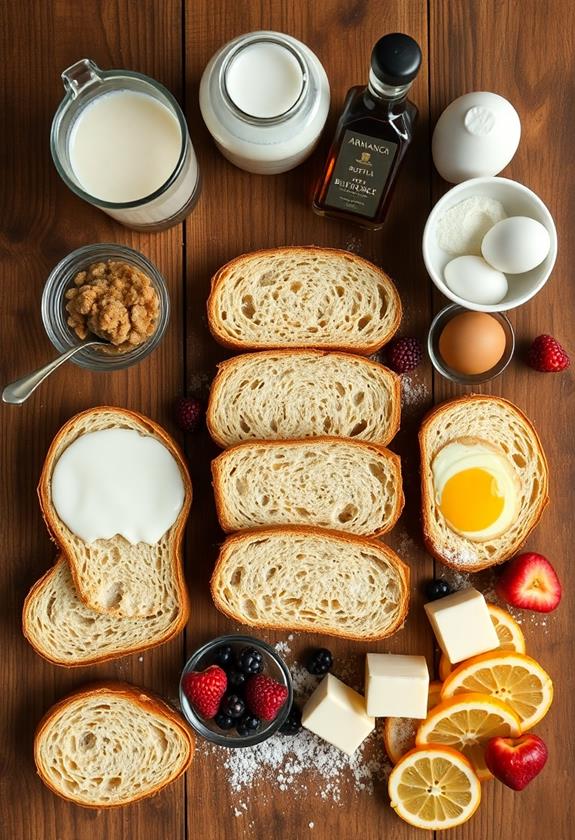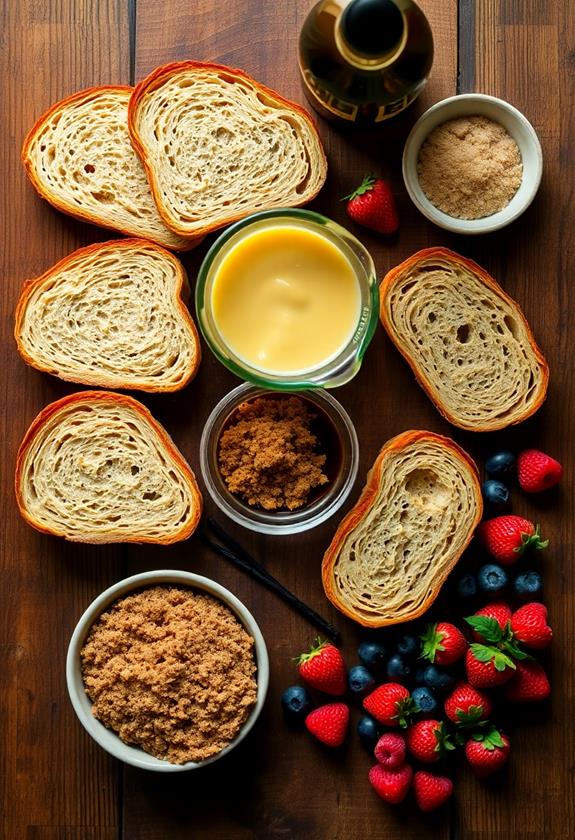Pain perdu, or "lost bread," is a delicious French dish that transforms stale bread into a comforting treat. Don't you hate wasting bread? This recipe calls for thick slices soaked in a mix of milk, cream, eggs, and vanilla for flavor. The best part is you leave it to soak for a full day! �� You'll then fry it until golden brown and finish it in the oven. Serve it warm, dusted with powdered sugar and fresh fruit. It's perfect for breakfast or dessert! Curious about variations and tips? There's more to explore when it comes to this tasty delight!
History

Pain Perdu, which means "lost bread," has its roots in France and serves as a demonstration of the resourcefulness of cooking with stale bread to minimize waste. Did you realize that this delightful dish can be traced back to Ancient Rome? Early Romans soaked bread in egg and milk, creating something similar to what we recognize today. This practice of reusing ingredients aligns perfectly with modern sustainable practices, such as using Bee's Wrap reusable food wraps to reduce plastic waste in the kitchen.
During the Middle Ages, Pain Perdu became popular among poorer families in Europe. They turned day-old bread into a tasty meal, preventing food waste. It's amazing how something that might be tossed out can become a delicious treat, right?
In the 16th century, the recipe made its way to America, thanks to Joseph French. Although the name "French Toast" came later, it helped elevate this humble dish.
In France, Pain Perdu is often enjoyed as a dessert or snack, rather than a breakfast item.
Isn't it fascinating how a simple dish like Pain Perdu tells a story of history and culture? It shows us the importance of reducing food waste while enjoying something delicious.
Recipe

Pain Perdu, or "lost bread," is a delightful way to transform stale bread into a rich and indulgent brunch dish. Originating from France, this recipe utilizes thick slices of bread, such as Bâtard or Pain de Campagne, which absorb a creamy custard mixture, resulting in a luscious flavor and texture.
The beauty of Pain Perdu lies in its simplicity and the ability to enhance the dish with various flavors, making it a versatile choice for any occasion. In addition to traditional cooking methods, using modern appliances like an air fryer can also create a crispy texture with less oil, similar to the way air fryers can reduce oil usage.
To create the perfect Pain Perdu, you'll want to prepare your custard mixture well in advance. Allowing the bread to soak for at least 24 hours guarantees that it fully absorbs the flavors of milk, heavy cream, eggs, and sugar, creating a decadent treat that's perfect for brunch gatherings.
The cooking process involves frying the soaked bread in butter for a delightful golden crust, followed by finishing it in the oven for that perfect crispiness on the outside while remaining soft on the inside.
Ingredients:
- 6 slices of stale thick bread (Bâtard or Pain de Campagne)
- 1 cup milk
- 1 cup heavy cream
- 4 large eggs
- 1/2 cup brown sugar
- 1 teaspoon vanilla extract
- 2 tablespoons Armagnac (optional)
- 4 tablespoons unsalted butter
- Powdered sugar (for serving)
- Fresh fruit or maple syrup (optional, for serving)
To cook the Pain Perdu, begin by whisking together the milk, heavy cream, eggs, brown sugar, vanilla, and Armagnac in a large bowl until well combined.
Place the slices of stale bread into the mixture, making sure they're fully submerged. Cover the bowl and refrigerate for at least 24 hours, allowing the bread to soak up the custard.
When ready to cook, heat a cast-iron skillet over medium heat and melt the butter. Carefully place the soaked bread in the skillet, frying each slice until golden brown on both sides, about 3-4 minutes per side.
Once browned, transfer the slices to a preheated oven at 350°F (175°C) for an additional 8-10 minutes to achieve a crisp exterior. Serve warm, dusted with powdered sugar and accompanied by fresh fruit or maple syrup, if desired.
Extra Tips: For the best results, use quality bread with a sturdy texture to make sure it holds up during soaking and cooking.
Feel free to experiment with flavors by adding spices such as cinnamon or nutmeg to the custard mixture. If you have dietary restrictions, consider substituting regular milk with almond or cashew milk and using gluten-free bread.
And remember, the longer the bread soaks in the custard, the richer the flavor will be, so don't rush this vital step!
Final Thoughts

Ultimately, savoring Pain Perdu is a delightful experience you won't want to miss. This French toast dish isn't just about using stale bread; it's about creating magic with flavor absorption from a rich custard mixture.
Imagine biting into a slice that has a crispy exterior and a soft, custardy center. Doesn't that sound amazing? To enhance your breakfast experience, consider incorporating fresh juice from a high juice yield masticating juicer to complement the dish.
To get the best results, remember the soaking time is key. Letting your bread soak for at least 24 hours is essential for that perfect texture and flavor. While Pain Perdu is often enjoyed as a breakfast treat, it can also double as a rich dessert, depending on how you serve it.
Have you ever thought about pairing it with fresh fruit or a drizzle of syrup?
Now, let's talk nutritional information. Each serving packs around 728 calories, offering a good mix of carbohydrates, fat, and protein. So, while it's a delicious choice, it's also quite indulgent!
Whether you enjoy it for brunch or dessert, Pain Perdu is sure to impress. So, why not give it a try? You won't regret it!

